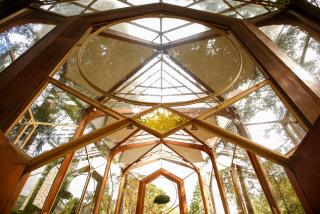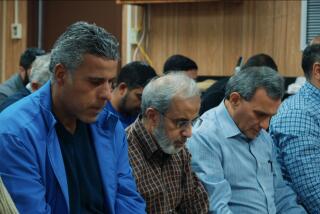Muslims to Buy Leased Prayer Site
- Share via
THOUSAND OAKS — By the grace of God--and at a price of about $500,000--the Islamic Center of Conejo Valley has found its first permanent home--one that will accommodate the growing number of Muslims living or working in the area.
This fall, the center plans to use existing funds and expected donations to buy the 5,000-square-foot Borchard Road mosque it has been leasing since October, according to Mohammed Elshafie, president of the center’s board of directors. The mosque, located in a former preschool, has a prayer hall with a capacity of 150.
About 200 Muslims attend Friday sermons here on a regular or periodic basis, and the crowd averages about 75 people, he said.
Local Muslim leaders said they hope that with eight Sunday school classrooms and 46 parking spaces, the new mosque will meet their needs for at least a decade.
“We’re so happy [because] all the people wouldn’t fit in” the former location, said Tariq Butt, the center’s treasurer.
The Islamic Center moved into the mosque after seven years in a cramped warehouse on Lavery Court.
The prayer hall there held only 60 and had only five classrooms and limited on-site parking, forcing most worshipers to park their
vehicles on a narrow street.
Muslim leaders and religion experts do not chart the number of Muslims living in Ventura County, and estimates of their population in the U.S. vary.
A survey by the Center for American Muslim Research and Information in New York estimated that there are 6.1 million Muslims in the country, up from the center’s 1990 estimate of 4.9 million.
However, a 1991 Gallup Poll estimated the number at 2 million or less.
Religious leaders say increases in attendance at prayer halls throughout Southern California during the past two decades signify an overall population increase.
“Thank God, we are increasing very rapidly,” said Mahmood Ali, the Islamic Center of Northridge’s accountant. That organization left its mosque, with a capacity of 100, in May and moved into a building with three times as much space.
Salam Al-Marayati, spokesman for the Muslim Public Affairs Council in Los Angeles, said the apparent growth in Ventura County is a reflection of a national trend. Many immigrant Muslims are just following the same patterns in housing and lifestyle choices as other Americans.
“They’re moving out to the suburbs and rural areas,” he said. “There’s more space and cheaper land.”
This fall, the Islamic Center of Conejo Valley plans to purchase property from Conejo Valley resident Iraj Broomand and spend an additional $100,000 on improvements, using existing funds and donations from Islamic centers throughout the area.
“It’s all privately supported,” Elshafie said.
With prayer leaders and teachers volunteering their services, the Islamic Center operates on an annual budget of $25,000--most of which pays for utilities, he said.
The Friday noon prayer service--”jum’aa,”--includes many people who work in the Conejo Valley but live in Los Angeles or Santa Barbara counties.
A few also pray in the early afternoon on other days.
Children from 4 to 16 years old also attend Sunday school.
“It’s something we need in this country--awareness of our religion,” said Elshafie, referring to all people and religions. “It’s a way of combating social illness in society.”
As recently as the mid-1970s, Conejo Valley’s five known Muslim families used one another’s homes as makeshift mosques, he said.
A decade later, about 50 Muslims established Conejo Valley’s first Islamic Center, renting space in the First Lutheran Church in Thousand Oaks.
In 1990, the center moved into the warehouse. But with only 1,800 square feet of space, another move was inevitable.
Bader Iqbal, the center’s vice president, said he hopes the Borchard Road mosque will accommodate the congregation for at least a decade.
“We’re utilizing [only] half the capacity,” he said.
The Islamic Center moved into its present location last October, and has been operating on a special permit from the Planning Department.
City officials recently granted final approval, contingent upon a commitment to make necessary improvements.
Plans call for paving and installing lights in the parking lot, landscaping the two-acre parcel, construction of a handicapped-accessible ramp and a new wall separating the front patio from the parking lot.
More to Read
Sign up for Essential California
The most important California stories and recommendations in your inbox every morning.
You may occasionally receive promotional content from the Los Angeles Times.










